#des moines river
Text
Travel Experiences in Southeast Iowa!
Over the years I have learned that Iowa is a truly lovely and beautiful state. The Southeastern part of the state hold several treasures, some that I have visited for years, and others just recently discovered. Read about all the fun you can have in the Hawkeye State!
Amana Colonies
The Amana Colonies are a place that we have been enjoying during the holidays and year-round for decades. The…

View On WordPress
#amana#Amana Colonies#Amana Villages#art#Bentonsport Bridge#Bentsonsport Iowa#Bonaparte Iowa#Bonaparte Retreat#Carnegie library#Christian Metz#Communal Kitchen#Des Moines River#Die Hiement Country Inn#Fairfield Iowa#firsts#general store#German history#Gordon Kallenberger#Hawkeye state#history useum#Homstead Iowa#Hotel Millwright#house tour#Iowa State Fairs#Iron and Lace#Katlynne Hummell Underhill#Maasdam Barns#mill#Mill Race#mural
0 notes
Text
Qui sont les nouveaux streamers sur Qsmp? Allons-nous découvrir tous les jours?
#qsmp#je ne sais pas......#je sais tubbo et niki et river mais je ne sais pas si c'est un rumeur?#je pense ça je sais moins de qsmp que je sais =w=“
3 notes
·
View notes
Video
Des Moines River 7/3/23 by Sharon Mollerus
0 notes
Note
I’ve been reading some craft books and online posts about the world building because my story is an urban fantasy set in present day US, in a fictional town, and theres not a secondary world where the fantasy happens, it’s all in the real world, except the magic is a secret that only certain people know about, but all of the resources I find about world building only talk about fantastical worlds that exist by themselves and not the kind of more subtle world building that I’d have to do. Do you have any tips?
Guide: Creating a Fictional Town in the Real World
Step 1 - Choose Your Location - There are two ways to go about choosing a location for your fictional town. One is to go the "Springfield U.S.A." route, ala The Simpsons, and be vague about the specific location (borough, parish, district, county, region, state, or province) and instead give a broader geographic region... "the East Coast," "the Pacific Northwest," "Central Canada," Northern Scotland," etc. The other option is to go ahead and put your fictional town in a specific location. Just figure out where (for example, somewhere outside of Des Moines, Iowa) and go to Google Maps, click on satellite view, then start zooming in on big empty areas. Choose a place big enough to fit a town. Yes, in reality it's probably farm fields, pasture, or someone's property, but that doesn't matter. You don't have to actually show it on a map. It's just a plausible spot to build your town. Now you can measure how far it is to other places, you know what highways to take to get to it. You can even do street view to get the lay of the land, see what the landscape looks like and try to envision the buildings there. You can also use what's there to create parks, popular recreational areas, and anything else your town needs.
Step 2 - Choose Your Inspiration - Even when you're creating a fictional town, it's still a good idea to use a real town (or two, or three) from that general area as inspiration for your town. For a fictional town in Des Moines, I would zoom in on the map to find a nearby town of similar size... like Elkhart, then I can take a look around to see what it's like. Just looking at the map, I can see they have a couple of churches, a couple baseball fields, a very small main street/downtown area with a couple shops and restaurants, a post office, a few different neighborhoods, and a cemetery. This would be a great model for a small fictional town outside of Des Moines. And, as I said, you could look at a couple other sand combine them. Once you have your inspiration town/s, you can walk around on Google Maps street view, go to the town's web site, watch a tour on YouTube (if one exists), or look up pictures in Google Image search.
Step 3 - Start Planning - This is the really fun part! First, you might want to draw a basic map of your fictional town using your inspiration town/s as a guide. This doesn't have to be a pretty map... just a basic line drawing to help you envision where everything is. Think about some of the basic things this town might have, like the ones I listed in step two, and any other things you might want your town to have, like maybe a library, a hospital, a city hall, school, and maybe a movie theater. It might even be helpful and fun to put together a collage of pictures to represent your town so you've got something in mind as you write about it. You can even choose representatives for specific locations in your story, like your MC's house, school, and their favorite hangout.
Step 4 - Naming Your Town - Start by looking at the kinds of town names that surround your town. Look for common naming conventions... suffixes like -ton, -ville, -dale, -burg, -wood, -field, etc. Words in a particular language, like a lot of French-inspired town names, or towns with geographical terms (lake, hill, valley, river, canyon, gap, etc.) My guide to Naming Locations has additional tips.
Step 5 - Populate Your Town and Give it a History - Last but not least, make up a little history for your town, again, using surrounding towns as inspiration. Who founded it? When was it founded? What's the town's main industry? What are the people like in this town? What jobs do they have? What do they do for fun?
Here are some other posts that might help:
Five Things to Help You Describe Fictional Locations
Setting Your Story in an Unfamiliar Place
WQA’s Guide to Internet Research
Happy writing!
•••••••••••••••••••••••••••••••••
I’ve been writing seriously for over 30 years and love to share what I’ve learned. Have a writing question? My inbox is always open!
♦ Questions that violate my ask policies will be deleted!
♦ Please see my master list of top posts before asking
♦ Learn more about WQA here
86 notes
·
View notes
Text

(10/30/1995)An aerial view of the Philadelphia Naval Shipyard looking southeast. The shipyard closed on September 30, 1995, but the Navy Intermediate Ship Maintenance Facility (NIMSF) will continue to store decommissioned and mothballed ships. Visible are the battleships IOWA (BB-61) and WISCONSIN (BB-64); the aircraft carriers FORESTALL (CV-59) and SARATOGA (CV-60); three supply ships; 2 amphibious assault ships) along the Delaware River. In the back pool are the heavy cruiser DES MOINES (CA-134) and numerous frigates..USN Image Robert J. Sitar
24 notes
·
View notes
Photo
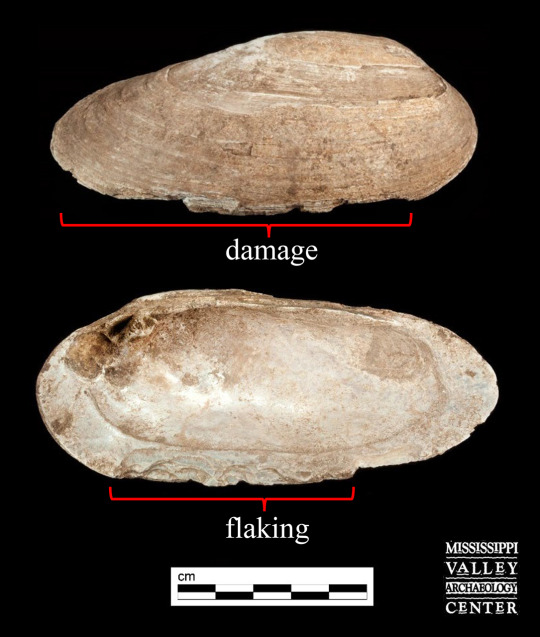
People in the past fashioned tools out of not just a variety of animal bones, but mussel shell as well. This complete right valve (shell) of a black sandshell (Ligumia recta) mussel from 2012 MVAC excavations beneath STH 35 in Onalaska, Wisconsin, is just one example. It was used for scooping, scraping, or digging, as shown by wear along the long edge opposite the hinge, where the left and right halves of the mussel shell would join. Damage is visible on the outside of the shell (top), as is flaking on the inside of the shell (bottom). This edge of the shell, given it came from a black sandshell, likely would have been razor-sharp initially.
Though not a common artifact for La Crosse area Oneota sites, similar modified and edge-damaged shells at Oneota sites along the Des Moines River in Iowa and to the west have been shown to have been used for shelling the kernels from ears of parboiled green corn. An extensive literature review and ethnographic studies by the late Dr. David Gradwohl found that a number of Native American tribes employed mussel shells in a rather elaborate process of preparing corn for immediate consumption or storage. Interestingly, at Iowa Oneota sites, the black sandshell was the preferred species used for the proposed corn shellers (see Gradwohl 1982:135–156). The black sandshell is not uncommon in large and medium rivers of the Midwest, including the Mississippi.
Gradwohl, David Mayer
1982 Shelling Corn in the Prairie-Plains: Archaeological Evidence and Ethnographic Parallels beyond the Pun. In Plains Indian Studies: A Collection of Essays in Honor of John C. Ewers and Waldo R. Wedel, edited by Douglas H. Ubelaker and Herman J. Viola, pp. 135–156. Smithsonian Contributions to Anthropology No. 30. Smithsonian Institution, Washington DC.
38 notes
·
View notes
Text
The description of the Roman onlookers is rather more picturesque in Buss’s translation than in the older translation:
... une cinquantaine de badauds des États de Sa Sainteté, de ceux-là qui font des ronds en crachant dans le Tibre du haut du pont Saint-Ange, quand le Tibre a de l’eau.
... about fifty little vagabonds from the Papal States, who earned a pittance by diving into the Tiber at high water from the bridge of St. Angelo.
... some fifty idlers from the Papal States, of the sort who make rings in the water by spitting into the Tiber from the Ponte Sant’ Angelo, when there is water in the river.
During the conversation between Peppino and the bank clerk, the older translation skips part of their discussion of the Russian traveller who didn’t have as much money as expected:
—Vous aurez mal cherché.
—C’est Luigi Vampa qui a fait la perquisition en personne.
—En ce cas, il avait ou payé ses dettes...
—Un Russe?
—Ou dépensé son argent.
—C’est possible, après tout.
“You must have searched badly.”
“Luigi Vampa himself searched.”
“You probably didn’t look hard enough.”
“Luigi Vampa did the search in person.”
“In that case, either he had paid his debts...”
“A Russian?”
“Or spent the money.”
“I suppose that’s possible.”
And also part of their reaction to the amount Danglars has:
—C’est bien lui... Cinq millions. Une jolie somme hein, Peppino?
—Oui.
—Nous n’en aurons jamais autant.
—Au moins, répondit philosophiquement Peppino, en aurons-nous quelques bribes.
—Chut! Voici notre homme.»
“Yes, it is indeed he. Five millions—a pretty sum, eh, Peppino?”
“Hush—here is our man!”
“It’s him all right. Five million... A fine sum, eh, Peppino?”
“Yes.”
“We’ll never have as much for ourselves.”
“At least we’ll get some crumbs of it,” Peppino said philosophically.
“Hush! Here he comes.”
Danglars, when he realises he’s in trouble:
Ses yeux prirent dans les ténèbres ce degré de finesse que communiquent dans le premier moment les émotions fortes, et qui s’émousse plus tard pour avoir été trop exercé. Avant d’avoir peur, on voit juste; pendant qu’on a peur, on voit double, et après qu’on a eu peur, on voit trouble.
His eyes acquired that quality which in the first moment of strong emotion enables them to see distinctly, and which afterwards fails from being too much taxed. Before we are alarmed, we see correctly; when we are alarmed, we see double; and when we have been alarmed, we see nothing but trouble.
In the darkness his eyes took on that degree of acuity that strong emotions tend to give them at first, only for the effect to be reversed later through overuse. Berfore one is afraid, one sees clearly; while one is afraid, one sees double; and after being afraid, one sees dimly.
The older translation is continuing to trim out religious references, with this being one of the larger elisions:
Un lit fait d’herbes sèches, recouvert de peaux de chèvre, était, non pas dressé, mais étendu dans un coin de cette cellule. Danglars, en l’apercevant, crut voir le symbole radieux de son salut.
«Oh! Dieu soit loué! murmura-t-il, c’est un vrai lit!»
C’était la seconde fois, depuis une heure, qu’il invoquait le nom de Dieu; cela ne lui était pas arrivé depuis dix ans.
A bed of dried grass covered with goat–skins was placed in one corner. Danglars brightened up on beholding it, fancying that it gave some promise of safety. “Oh, God be praised,” he said; “it is a real bed!”
A bed of dry grass, covered with goatskins, was not standing, but spread out in a corner of this cell. Seeing it, Danglars thought he saw the glowing symbol of his salvation.
“Oh, God be praised!” he murmured. “It’s a real bed!”
This was the second time in the last hour that he had called on the name of God, something that had not happened to him for ten years.
11 notes
·
View notes
Text
«Ce n'est même pas un combat pour la survie»: des soldats ukrainiens forcés à des « missions suicides»–New York Times
«Ils ne comprennent même pas où ils vont», résume (https://www.nytimes.com/2023/12/16/world/europe/ukraine-kherson-river-russia.html)le média qui a cessé de tenter de faire croire à une victoire ukrainienne.
Le commandement qui les a envoyés là-bas ne leur dit rien
Des vagues de troupes ukrainiennes sont abattues lors de tentatives vaines de traverser le fleuve Dniepr à Kherson. ou dans le l'eau, avant même qu'ils n'atteignent la berge.
Bien que les commandants aient refusé aux médias de visiter les troupes dans la région, les images de drones de la zone témoignent du carnage, notamment dans la zone de Krynky (https://maps.app.goo.gl/x1AXw3fUP9CsPiHT7), fragile tête de pont de l'armée du Kiev.
Washington a exigé de Kiev non plus une «victoire» contre la Russie, mais au moins quelques succès militaro-médiatiques, afin de préparer des pourparlers «inévitables».
2 notes
·
View notes
Text
"Microsoft's data centers in West Des Moines, Iowa guzzled massive amounts of water last year, the Associated Press reported earlier this month, to keep cool while training OpenAI's ChatGPT-4, the Microsoft-backed company's most advanced publicly available large language model.
Critics point out a further inconvenient detail: this happened in the midst of a more than three-year drought, further taxing a stressed water system that's been so dry this summer that nature lovers couldn't even paddle canoes in local rivers.
"It's a recipe for disaster," Iowa Citizens for Community Improvement organizer Jake Grobe told Futurism. "ChatGPT is not a necessity for human life, and yet we are literally taking water to feed a computer.""
3 notes
·
View notes
Photo

[CANNES 2023] NOTRE TOP
Le Festival de Cannes est désormais terminé. On a vu pas moins de 85 films (dont 19 sur les 21 de la Compétition), toutes catégories confondues !
Le classement de nos films préférés parmi ceux-ci, avec les dates annoncées de sortie en salles, ci-dessous :
1. ‘Eureka’ de Lisandro Alonso (CPR)
2. ‘Le Procès Goldman’ de Cédric Kahn (QC, 27/09)
3. ‘Anatomie d’une chute’ de Justine Triet (SOC, 23/08)
4. ‘Jeunesse (Le Printemps)’ de Wang Bing (SOC, 03/01/24)
5. ‘L'Enlèvement’ de Marco Bellocchio (SOC, 01/11)
6. ‘Les Feuilles mortes’ d’Aki Kaurismaki (SOC, 20/09)
7. ‘Fermer les yeux’ de Victor Erice (CPR, 16/08)
8. ‘May December’ de Todd Haynes (SOC)
9. ‘La Zone d’intérêt’ de Jonathan Glazer (SOC, 31/01/24)
10. ‘L'Eté dernier’ de Catherine Breillat (SOC, 13/09)
11. ‘The Sweet East’ de Sean Price Williams (QC)
12. ‘Los Delincuentes’ de Rodrigo Moreno (UCR, 27/03/24)
13. ‘La Grâce’ d’Ilya Povolotsky (QC)
14. ‘Only the River Flows’ de Shujun Wei (UCR)
15. ‘Les Herbes sèches’ de Nuri Bilge Ceylan (SOC, 12/07)
16. ‘Conann’ de Bertrand Mandico (QC, 28/11)
17. ‘La Chimère’ d’Alice Rohrwacher (SOC, 06/12)
18. ’La Fille de son père’ d’Erwan Le Duc (SM, 20/12)
19. ’Lost Country’ de Vladimir Perisič (SC, 11/10)
20. ‘Conte de feu’ de Weston Razooli (QC)
21. ‘Mars Express’ de Jérémie Périn (CPL, 22/11)
22. ‘Vers un avenir radieux’ de Nanni Moretti (SOC, 28/06)
23. ‘L’Autre Laurens’ de Claude Schmitz (QC, 04/10)
24. ‘Elémentaire’ de Peter Sohn (HC, 21/06)
25. ‘Banel & Adama’ de Ramata-Toulaye Sy (SOC, 30/08)
26. ‘Anselm, le bruit du temps’ de Wim Wenders (SS, 18/10)
27. ‘Le Règne animal’ de Thomas Cailley (UCR, 04/10)
28. ‘Simple comme Sylvain’ de Monia Chokri (UCR, 08/11)
29. ‘Ama Gloria’ de Marie Amachoukeli (SC, 30/08)
30. ‘Club Zéro’ de Jessica Hausner (SOC, 27/09)
31. ‘Linda veut du poulet !’ de Chiara Malta et Sébastien Laudenbach (ACID, 18/10)
32. ‘Si seulement je pouvais hiberner’ de Zoljargal Purevdash (UCR, 27/12)
33. ‘L’Amour et les forêts’ de Valérie Donzelli (CPR, en salles)
34. ‘La Mère de tous les mensonges’ d’Asmae El Moudir (UCR)
35. ‘Légua’ de Filipa Reis et João Miller Guerra
36. ‘The Feeling That the Time for Doing Something Has Passed’ de Joanna Arnow (QC)
37. ‘Augure’ de Baloji (UCR, 22/11)
38. ‘Les Colons’ de Felipe Galvez (UCR, 20/12)
39. ‘Vincent doit mourir’ de Stéphan Castang (SC, 15/11)
40. ‘De nos jours...’ de Hong Sang-soo (QC, 19/07)
41. ‘Merle merle mûre’ d’Elene Naveriani (QC)
42. ‘Dans la toile’ de Kim Jee-woon (HC, 08/11)
43. ‘The Old Oak’ de Ken Loach (SOC, 25/10)
44. ‘Monster’ de Hirokazu Kore-eda (SOC, 27/12)
45. ’Sleep’ de Jason Yu (SC)
46. ‘Occupied City’ de Steve McQueen (SS)
47. ‘Bonnard, Pierre et Marthe’ de Martin Provost (CPR)
48 ‘Goodbye Julia’ de Mohamed Kordofani (UCR, 08/11)
49. ‘L’Arbre aux papillons d’or’ de Thien An Pham (QC, 13/09)
50. ‘Chambre 999’ de Lubna Playoust (CC)
51. ‘Le Livre des solutions’ de Michel Gondry (QC, 13/09)
52. ‘Les Meutes’ de Kamal Lazraq (UCR, 19/07)
53. ‘Le Ravissement’ d’Iris Kaltenbäck (SC, 11/10)
54. ‘Little Girl Blue’ de Mona Achache (SS, 01/11)
55. ‘Creatura’ d’Elena Martín Gimeno (QC)
56. ‘Perfect Days’ de Wim Wenders (SOC, 29/11)
57. ‘Lost in the Night’ d’Amat Escalante (CPR, 04/10)
58. ‘La Fleur de Buriti’ de João Salaviza et Renée Nader (UCR)
59. ‘Le Syndrome des amours passées’ d’Ann Sirot et Raphaël Balboni (SC, 25/10)
60. ‘Un hiver à Yanji’ d’Anthony Chen (UCR, 22/11)
61. ’Power Alley’ de Lillah Halla (SC, 22/11)
62. ‘Asteroid City’ de Wes Anderson (SOC, 21/06)
63. ‘Une nuit’ d’Alex Lutz (UCR, 05/07)
64. ‘Les Filles d'Olfa’ de Kaouther Ben Hania (SOC, 05/07)
65. ‘Indiana Jones et le cadran de la destinée’ de James Mangold (HC, 28/06)
66. ‘Chroniques de Téhéran’ d’Ali Asgari & Alireza Khatami (UCR, 27/12)
67. ‘Acide’ de Just Philippot (SM, 20/09)
68. ‘Un prince’ de Pierre Creton (QC, 18/10)
69. ‘Déserts’ de Faouzi Bensaïdi (QC, 20/09)
70. ’Il pleut dans la maison’ de Paloma Sermon-Daï (SC)
71. ‘Rien à perdre’ de Delphine Deloget (UCR, 22/11)
72. ‘La Passion de Dodin Bouffant’ de Tran Anh Hung (SOC, 08/11)
73. ‘How to Have Sex’ de Molly Manning Walker (UCR, 15/11)
74. ‘Le Jeu de la reine’ de Karim Aïnouz (SOC, 28/02/24)
75. ‘A Song Sung Blue’ de Zihan Geng (QC, 06/12)
76. ‘Jeanne du Barry’ de Maïwenn (HC, en salles)
77. ‘Rosalie’ de Stéphanie di Giusto (UCR, 24/01/24)
78. ‘In Flames’ de Zarrar Kahn (QC)
79. ‘Hopeless’ de Kim Chang-hoon (UCR)
80. ’Tiger Stripes’ d’Amanda Nell Eu (SC, 13/03/24)
81. ‘The Idol’ (série, épisodes 1 et 2) de Sam Levinson (HC, 05/06)
82. ‘The New Boy’ de Warwick Thornton (UCR)
83. ‘Omar la Fraise’ d’Elias Belkeddar (SM, en salles)
84. ‘Hypnotic’ de Robert Rodriguez (SM, 23/08)
85. ‘Agra’ de Kanu Behl (QC)
SOC : Sélection Officielle - Compétition
UCR : Un Certain Regard
CPR : Cannes Première
CPL : Cinéma de la Plage
HC : Hors Compétition
QC : Quinzaine des Cinéastes
SC : Semaine de la Critique
SM : Séances de Minuit
CC : Cannes Classics
ACID : L’ACID
Nos chroniques de ces films sont à retrouver dans les articles Daily #1 à #11 sur notre page dédiée.
A&B
6 notes
·
View notes
Text
RAGBRAI Part 2 (Iowa)
22-29 July 2023
This is Part Two of my account of this year’s ride across Iowa. These posts have been festering in a ‘drafts’ folder for a month and a half and now I’m determined to just get them out. This one is more of a chronological account of the last few days of the ride, combined with some overall observations of the whole spectacle.

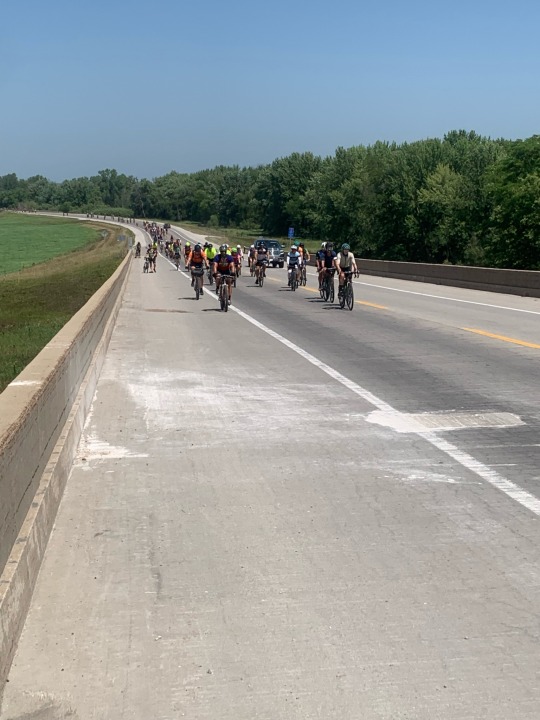
Day 5 of RAGBRAI began with a beautiful pre-dawn ride through downtown Des Moines and out of the city to the east. This was the longest and hilliest day of the week-long ride, covering about 90 miles and climbing 4000’. We passed through Newton, where I’d stayed on my eastbound ride in 2019 and Grinnell before ending the day in the twin towns of Tama and Toledo.

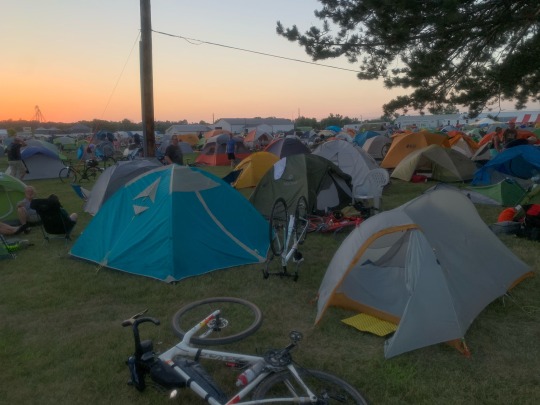
Day 6 included Marengo and the Amana villages, but Oxford has become the most memorable pass-through town of the whole trip for me, simply because of the heat. The fire station doors were wide open and there were tables lined with folks enjoying shade and cooling fans and ice cream. There was an old fire truck parked outside and an open hydrant spraying water across the passing riders (all walking their bikes through town). The final 15 miles to Coralville was miserable but misery shared among thousands. It was hilly and hot and humid (‘feels like 113’). People, including me, were stopping at virtually every hilltop farmhouse to sit in the grass under the trees and to empty water bottles over our heads. Everyone was checking on everyone else for signs of heat stroke. And there were clearly several riders along side the road getting attention (from other cyclists and from occasional ambulances).
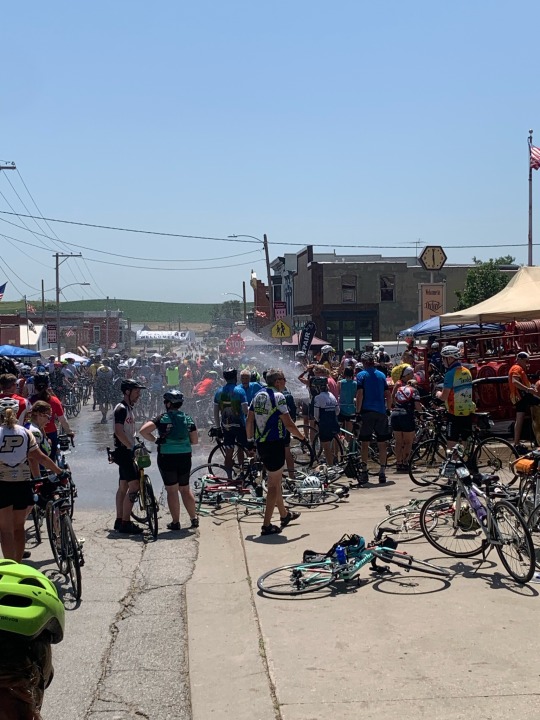
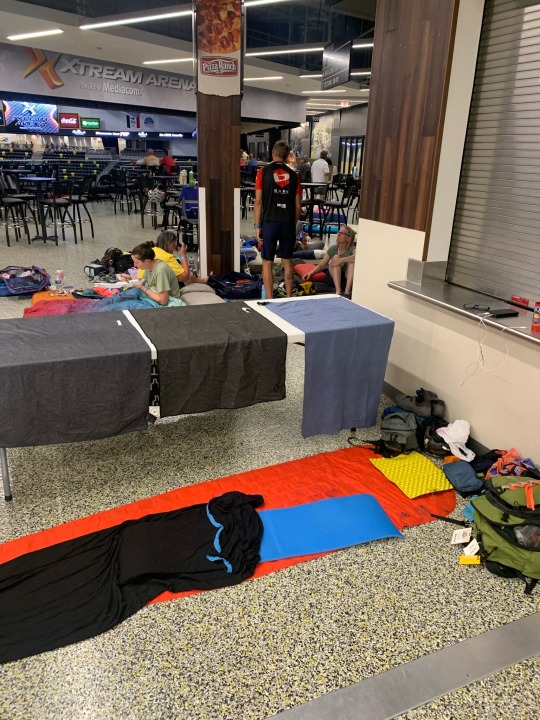
I arrived at the Pork Belly camp in Coralville around 3:00. I was not looking forward to pitching my tent in the hot sun, so when I heard that they had opened up more space in the nearby Xtreme Arena for a small donation, I jumped on it. I set up ‘camp’ on the concourse, amidst many others. I didn’t even hear the sirens and commotion outside when the storm arrived two hours later. Strong winds were tossing tents around and sending folks fleeing for the arena (which they had opened for everyone by then). Pork Belly moved the dinner service and the band into the arena which was wonderful (this was still mainly just the Pork Belly crowd, so while it was crowded, it was pretty spread out given the size of the facility. Things were crazier in the main RAGBRAI camps). It was so nice to spend a night in an air conditioned space.

Saturday (Day 7) was a very early start because of the potential heat and the urgency about getting to Davenport in time to get the afternoon shuttle back to Omaha. Route finding out of Coralville and through Iowa City in the dark at 5:30 was confusing, in part because the route was designed to go through the University of Iowa and Kinnick Stadium, but that wasn’t actually open until 6:00 am and instructions weren’t clear. The 70 miles went fast and was one of the nicest rides of the trip, in part due to cloud cover. We reached the Mississippi River in Muscatine, but then followed it the final 25 miles to Davenport. I stopped for ice cream at a Beekman’s stand along the way and joined others on plastic chairs along the shoulder cheering the crowd as they rode by (in previous days, the lines at Beekman’s had always been prohibitively long and the lack of cloud cover meant little interest in sitting anywhere without shade).
I dipped my wheel in the Mississippi around 11:00 (I’ve never ridden 70 miles by 11:00 am before!). The boat ramp was crowded, but it was only a few minute wait (I heard that by afternoon the line was much, much longer). I took my time riding along the riverfront park - this is where I crossed the Mississippi River in 2019 on my way west. Then it was a mile uphill to the St. Ambrose campus, where Pork Belly was set up. I put my bike on the ‘Stupidity’ trailer, retrieved my bags, visited the shower truck, grabbed a burger and a drink, and made it onto the first (of 8?) coaches headed back to Omaha that afternoon.
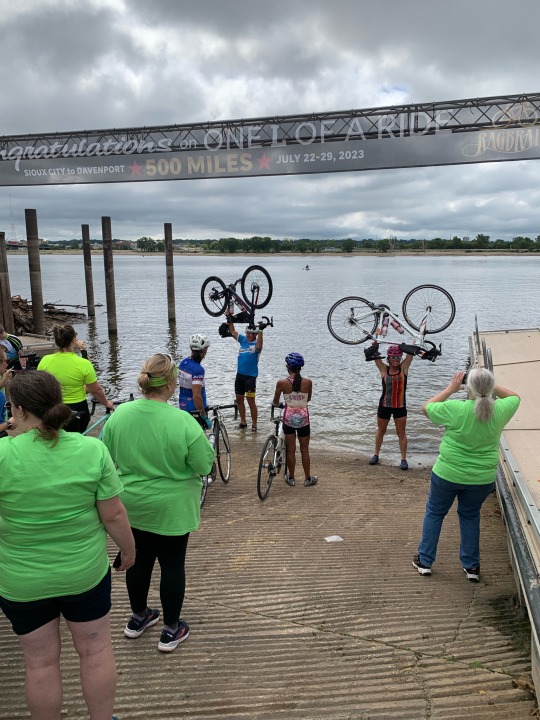
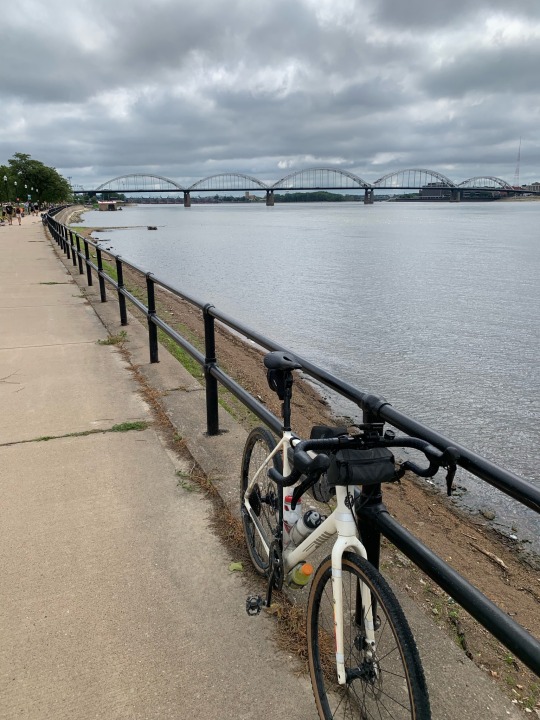
The bus trip was 5-6 hours, all on I-80, but it went by quickly. Everyone was excited about finishing the 7-day ride (and having already ridden 70 miles just that morning). I think we all let our guards down, since I’m pretty sure that’s where I picked up COVID, which I proceeded to share with M and C when I arrived home two days later!
Aside from the heat and the crowds and the lines, RAGBRAI was an amazing experience. I’m really glad I did it. Once. I appreciate that many people will want to do it again and again. But it’s just not the kind of experience I ride for. I like solitude. I like the interaction with locals in their normal lives, not during a traveling festival that has turned their lives upside down for a day. I don’t like heat and mugginess and damp gear that never dries out and sleeping in a tent when the temperature never drops below the high 70s. I’ve always been a bit bugged by the collegiate focus on partying and drinking - which may not accurately characterize most participants, but which was a dominant theme leading up to and during the event. Serving up vodka lemonade slushies in front yards and crowded beer gardens and countless Facebook posts about riding from beer stop to beer stop along the route contributes to this.
I talked to a lot of other riders on this trip. They came from a wide variety of places and personal histories and biking backgrounds. It was a great reminder of how different we all are, in what we’ve done, what we enjoy, and what inspires us, despite the fact that we all share an interest in the same thing and look sort of the same in our Lycra and our helmets.
I spent the week thinking how this ride compared with 2019. That was a tough five days, but if I ever want to ride across Iowa again, that’s the way I’d do it. And while I enjoy the landscapes of the Midwest, I’d rather be riding in the mountains or along the coast, through the forest or in a dramatic urban landscape.

2 notes
·
View notes
Note
sorry im asking so much about Iowa atm haha but, are there actually any, like, big grassy natural plains/steppes etc there anymore? or is it all farmland?
I'm curious bc obviously outside the US we hear about the ~Great Plains~ and I always kinda vaguely imagined wild horses and bison and endless waves of rippling green/gold tall wild grass, but I know that's at least partially romanticized and not very realistic generally anymore. Like I get it's a lot of agriculture and fields, I'm also from a smalltown farmville, but as someone from the UK, I can't like... fathom just how honestly kinda terrifyingly HUGE the US is, like all that SPACE, and comprehend that it's just. ALL been used up and tamed and. I just. That doesnt make sense in my brain. But if you look on google earth/maps/whatever and its?? ALL little regimented square fields?? like tens of times the size of Wales (my country)of them before what looks like unprocessed(? if that makes sense) land?
sorry if this comes across insensitive or weird or smth, I'm aware part of it is gonna be to do with Colonialism and Native American land and stuff I'm not in any way qualified to talk abt just. in the most neutral way possible, the sense of cosmic fear that level of control over that much land awakens in me is fascinating and i need to know more. Do you have meadows, like real overgrown ones full of bees, or are they gone? what's the deal with land ownership and walking around, like how does trespassing work when all the space surrounding you forever is owned by a human to productively use without any breaks of no mans land anywhere????? the more I think about it the more questions I have
So Iowa is actually the #2 state with the most private land, 97.2%, which actually surprised me!
About 1% of the tallgrass prairie and 5% of the prairie pothole wetlands are left. 60% of our land use is for crops, which are primarily corn and soybeans. It's a bit of a pet peeve when people use wheat fields to represent Iowa because I almost never see wheat grown. (I could complain about how bad it is on the soil to only have a 2-crop rotation but that's a conversation for another time)
I don't have GIS software on my personal PC although I wish I did to get you some better looks at the land, but this is due south of the capital city of Des Moines. The patchwork is all cropfields with intersecting branches off the Des Moines rivers and her tributaries. There is a state park on this map and it's pretty often people would go there for the weekend. We all go to the lake on the weekend in summers, which I miss dearly now that I am down in dry dry Texas.

Bison are only found in captivity now. My favorite place to see them is the Neal Smith National Wildlife Refuge, but they don't run wild like they did pre-European colonization.

Photo by Richard C. Hager/USFWS
You absolutely have to have permission from a landowner to walk around on their land or else they can prosecute you for trespassing. There are places to go, for example, every county has a county conservation board that maintains some more "wild" parks, but theyre a mix of woodland and grassland for the most part. To me, it kind of seems normal but I know it's obviously very weird. I've gone out to people's land to fish or play outside so much, and there are also conservation organizations like the Izaak Walton League that you can buy a membership (or go as someone's guest) to visit.
but yea, it's mostly corn as horrifying as that is!
5 notes
·
View notes
Text

The 2020 Derecho was really devastating for a lot of Iowa and Illinois, Cedar Rapids in particular, and Iowans were begging people online to take notice to very little effect. I made this meme after the Texas freeze in 2021, which got a lot of attention online, even though much of it was in the form of mockery.
The Floods of 1993 I think most people know about, since it affected so many people, but if not: The Great Flood of 1993. This was a huge deal in Des Moines, notably the Water Works was flooded and the city was without drinking water from July 12-30. have seen some reporting on the 30-year anniversary and expect to see more as the summer goes on. [Photo gallery]
The 2008 floods hit Des Moines but had an even bigger impact on Cedar Rapids (that was one of the most heartbreaking parts of them getting so hammered by the derecho, they had done so much to rebuild after 2008). The 2011 insurance industry comedy "Cedar Rapids" with Ed Helms wasn't shot in CR but the characters did discuss the real-life flood event that had recently hit the city.
The 2018 floods were particularly scary since it all happened so fast. Fourmile Creek swelled from its banks, sweeping away people, pets, and vehicles, turned streets into rivers, filled basements, and in one case, ruptured a gas line that led to a duplex exploding (the residents escaped unharmed).
#Derecho#Floods of 1993#natural disasters#flooding CW#one of my friends got caught in the 2018 flood and it kind of messed her up for a while#totaled her car#I still try to text her when it's storming bad
3 notes
·
View notes
Text
December 10th:
The train passed rapidly across the State of Iowa, by Council Bluffs, Des Moines, and Iowa City. During the night it crossed the Mississippi at Davenport, and by Rock Island entered Illinois. The next day, which was the 10th, at four o’clock in the evening, it reached Chicago, already risen from its ruins, and more proudly seated than ever on the borders of its beautiful Lake Michigan.
Nine hundred miles separated Chicago from New York; but trains are not wanting at Chicago. Mr. Fogg passed at once from one to the other, and the locomotive of the Pittsburgh, Fort Wayne, and Chicago Railway left at full speed, as if it fully comprehended that that gentleman had no time to lose. It traversed Indiana, Ohio, Pennsylvania, and New Jersey like a flash, rushing through towns with antique names, some of which had streets and car-tracks, but as yet no houses. At last the Hudson came into view; and, at a quarter-past eleven in the evening of the 11th, the train stopped in the station on the right bank of the river, before the very pier of the Cunard line.
The “China,” for Liverpool, had started three-quarters of an hour before!
14 notes
·
View notes

